Cryo-Electron Microscopy of BfpB Reveals a Type IVb Secretin Multimer Adapted to Accommodate the Exceptionally Wide Bundle-Forming Pilus
Abstract
1. Introduction
2. Materials and Methods
2.1. Bacterial Strains and Plasmids
2.2. BfpB Protein Purification
2.3. Cryo-Electron Microscopy
2.4. Single-Particle Image Processing
2.5. 3D Model Building and Symmetry Application
2.6. Assessment and Purification of Putative Amino-Terminal Domains of BfpB
2.7. Thermal Stability Assay
3. Results
3.1. Purification of BfpB Multimer
3.2. Cryo-EM Reveals C17 Cyclic Symmetry
3.3. A C17 Model of BfpB
3.4. Confirmation of N0, and Stability of the N0-N3 Domain Pair
4. Discussion
5. Conclusions
Supplementary Materials
Author Contributions
Funding
Institutional Review Board Statement
Informed Consent Statement
Data Availability Statement
Acknowledgments
Conflicts of Interest
Abbreviations
| BFP | Bundle-Forming Pilus |
| EPEC | Enteropathogenic Escherichia coli |
| GSFSC | Gold-standard Fourier shell correlation |
| IM | Inner membrane |
| OD600 | Optical Density at 600 nm |
| OM | Outer membrane |
| LB | Luria–Bertani |
| PCR | Polymerase chain reaction |
| Ni-NTA | nickel nitrilotriacetic acid |
| SB3-14 | 3-(N, N-Dimethyltetradecylammonio) propane-sulfonate |
| T2S | Type 2 secretion |
| T2SS | Type 2 secretion system |
| T3S | Type 3 secretion |
| T3SS | Type 3 secretion system |
| T4aP | Type 4a pilus |
| T4bP | Type 4b pilus |
| T4P | Type 4 pilus |
References
- Pelicic, V. Type IV Pili: E Pluribus Unum? Mol. Microbiol. 2008, 68, 827–837. [Google Scholar] [CrossRef] [PubMed]
- Häse, C.C.; Mekalanos, J.J. TcpP Protein Is a Positive Regulator of Virulence Gene Expression in Vibrio cholerae. Proc. Natl. Acad. Sci. USA 1998, 95, 730–734. [Google Scholar] [CrossRef] [PubMed]
- Bradley, D.E. A Function of Pseudomonas Aeruginosa PAO Polar Pili: Twitching Motility. Can. J. Microbiol. 1980, 26, 146–154. [Google Scholar] [CrossRef] [PubMed]
- Collyn, F.; Léty, M.A.; Nair, S.; Escuyer, V.; Ben Younes, A.; Simonet, M.; Marceau, M. Yersinia Pseudotuberculosis Harbors a Type IV Pilus Gene Cluster That Contributes to Pathogenicity. Infect. Immun. 2002, 70, 6196–6205. [Google Scholar] [CrossRef]
- Meyer, T.F.; Billyard, E.; Haas, R.; Storzbach, S.; So, M. Pilus Genes of Neisseria Gonorrheae: Chromosomal Organization and DNA Sequence. Proc. Natl. Acad. Sci. USA 1984, 81, 6110–6114. [Google Scholar] [CrossRef]
- Goulding, D.; Thompson, H.; Emerson, J.; Fairweather, N.F.; Dougan, G.; Douce, G.R. Distinctive Profiles of Infection and Pathology in Hamsters Infected with Clostridium Difficile Strains 630 and B1. Infect. Immun. 2009, 77, 5478–5485. [Google Scholar] [CrossRef]
- Stone, B.J.; Abu Kwaik, Y. Expression of Multiple Pili by Legionella Pneumophila: Identification and Characterization of a Type IV Pilin Gene and Its Role in Adherence to Mammalian and Protozoan Cells. Infect. Immun. 1998, 66, 1768–1775. [Google Scholar] [CrossRef]
- Zhang, X.L.; Tsui, I.S.M.; Yip, C.M.C.; Fung, A.W.Y.; Wong, D.K.H.; Dai, X.; Yang, Y.; Hackett, J.; Morris, C. Salmonella Enterica Serovar Typhi Uses Type IVB Pili to Enter Human Intestinal Epithelial Cells. Infect. Immun. 2000, 68, 3067–3073. [Google Scholar] [CrossRef]
- Giltner, C.L.; Nguyen, Y.; Burrows, L.L. Type IV Pilin Proteins: Versatile Molecular Modules. Microbiol. Mol. Biol. Rev. 2012, 76, 740. [Google Scholar] [CrossRef]
- Kirn, T.J.; Lafferty, M.J.; Sandoe, C.M.P.; Taylor, R.K. Delineation of Pilin Domains Required for Bacterial Association into Microcolonies and Intestinal Colonization by Vibrio cholerae. Mol. Microbiol. 2000, 35, 896–910. [Google Scholar] [CrossRef]
- Mattick, J.S. Type IV Pili and Twitching Motility. Annu. Rev. Microbiol. 2002, 56, 289–314. [Google Scholar] [CrossRef] [PubMed]
- Luke, N.R.; Howlett, A.J.; Shao, J.; Campagnari, A.A. Expression of Type IV Pili by Moraxella Catarrhalis Is Essential for Natural Competence and Is Affected by Iron Limitation. Infect. Immun. 2004, 72, 6262–6270. [Google Scholar] [CrossRef] [PubMed]
- Hobbs, M.M.; Sparling, P.F.; Cohen, M.S.; Shafer, W.M.; Deal, C.D.; Jerse, A.E. Experimental Gonococcal Infection in Male Volunteers: Cumulative Experience with Neisseria Gonorrhoeae Strains FA1090 and MS11mkC. Front. Microbiol. 2011, 2, 123. [Google Scholar] [CrossRef] [PubMed]
- Xicohtencatl-Cortes, J.; Monteiro-Neto, V.; Ledesma, M.A.; Jordan, D.M.; Francetic, O.; Kaper, J.B.; Puente, J.L.; Girón, J.A. Intestinal Adherence Associated with Type IV Pili of Enterohemorrhagic Escherichia coli O157:H7. J. Clin. Investg. 2007, 117, 3519–3529. [Google Scholar] [CrossRef]
- Mazariego-Espinosa, K.; Cruz, A.; Ledesma, M.A.; Ochoa, S.A.; Xicohtencatl-Cortes, J. Longus, a Type IV Pilus of Enterotoxigenic Escherichia coli, Is Involved in Adherence to Intestinal Epithelial Cells. J. Bacteriol. 2010, 192, 2791–2800. [Google Scholar] [CrossRef]
- Farinha, M.A.; Conway, B.D.; Glasier, L.M.G.; Ellert, N.W.; Irvin, R.T.; Sherburne, R.; Paranchych, W. Alteration of the Pilin Adhesin of Pseudomonas Aeruginosa PAO Results in Normal Pilus Biogenesis but a Loss of Adherence to Human Pneumocyte Cells and Decreased Virulence in Mice. Infect. Immun. 1994, 62, 4118–4123. [Google Scholar] [CrossRef]
- Comolli, J.C.; Hauser, A.R.; Waite, L.; Whitchurch, C.B.; Mattick, J.S.; Engel, J.N. Pseudomonas Aeruginosa Gene Products PilT and PilU Are Required for Cytotoxicity In Vitro and Virulence in a Mouse Model of Acute Pneumonia. Infect. Immun. 1999, 67, 3625–3630. [Google Scholar] [CrossRef]
- Eugène, E.; Hoffmann, I.; Pujol, C.; Couraud, P.O.; Bourdoulous, S.; Nassif, X. Microvilli-like Structures Are Associated with the Internalization of Virulent Capsulated Neisseria meningitidis into Vascular Endothelial Cells. J. Cell Sci. 2002, 115, 1231–1241. [Google Scholar] [CrossRef]
- Anderson, M.T.; Dewenter, L.; Maier, B.; Steven Seifert, H. Seminal Plasma Initiates a Neisseria Gonorrhoeae Transmission State. mBio 2014, 5, e01004-13. [Google Scholar] [CrossRef]
- Bieber, D.; Ramer, S.W.; Wu, C.Y.; Murray, W.J.; Tobe, T.; Fernandez, R.; Schoolnik, G.K. Type IV Pili, Transient Bacterial Aggregates, and Virulence of Enteropathogenic Escherichia coli. Science 1998, 280, 2114–2118. [Google Scholar] [CrossRef]
- Tacket, C.O.; Taylor, R.K.; Losonsky, G.; Lim, Y.U.; Nataro, J.P.; Kaper, J.B.; Levine, M.M. Investigation of the Roles of Toxin-Coregulated Pili and Mannose-Sensitive Hemagglutinin Pili in the Pathogenesis of Vibrio cholerae O139 Infection. Infect. Immun. 1998, 66, 692. [Google Scholar] [CrossRef] [PubMed]
- Craig, L.; Forest, K.T.; Maier, B. Type IV Pili: Dynamics, Biophysics and Functional Consequences. Nat. Rev. Microbiol. 2019, 17, 429–440. [Google Scholar] [CrossRef] [PubMed]
- Ramer, S.W.; Schoolnik, G.K.; Wu, C.Y.; Hwang, J.; Schmidt, S.A.; Bieber, D. The Type IV Pilus Assembly Complex: Biogenic Interactions Among the Bundle-Forming Pilus Proteins of Enteropathogenic Escherichia coli. J. Bacteriol. 2002, 184, 3457. [Google Scholar] [CrossRef] [PubMed]
- Bayan, N.; Guilvout, I.; Pugsley, A.P. Secretins Take Shape. Mol. Microbiol. 2006, 60, 1–4. [Google Scholar] [CrossRef]
- Cianciotto, N.P. Type II Secretion: A Protein Secretion System for All Seasons. Trends. Microbiol. 2005, 13, 581–588. [Google Scholar] [CrossRef]
- Korotkov, K.V.; Sandkvist, M.; Hol, W.G.J. The Type II Secretion System: Biogenesis, Molecular Architecture and Mechanism. Nat. Rev. Microbiol. 2012, 10, 336–351. [Google Scholar] [CrossRef]
- Tosi, T.; Estrozi, L.F.; Job, V.; Guilvout, I.; Pugsley, A.P.; Schoehn, G.; Dessen, A. Structural Similarity of Secretins from Type II and Type III Secretion Systems. Structure 2014, 22, 1348–1355. [Google Scholar] [CrossRef]
- Marlovits, T.C.; Kubori, T.; Sukhan, A.; Thomas, D.R.; Galán, J.E.; Unger, V.M. Structural Insights into the Assembly of the Type III Secretion Needle Complex. Science 2004, 306, 1040–1042. [Google Scholar] [CrossRef]
- Spreter, T.; Yip, C.K.; Sanowar, S.; André, I.; Kimbrough, T.G.; Vuckovic, M.; Pfuetzner, R.A.; Deng, W.; Yu, A.C.; Finlay, B.B.; et al. A Conserved Structural Motif Mediates Formation of the Periplasmic Rings in the Type III Secretion System. Nat. Struct. Mol. Biol. 2009, 16, 468–476. [Google Scholar] [CrossRef]
- Conners, R.; McLaren, M.; Łapińska, U.; Sanders, K.; Stone, M.R.L.; Blaskovich, M.A.T.; Pagliara, S.; Daum, B.; Rakonjac, J.; Gold, V.A.M. CryoEM Structure of the Outer Membrane Secretin Channel PIV from the F1 Filamentous Bacteriophage. Nat. Commun. 2021, 12, 6316. [Google Scholar] [CrossRef]
- Marvin, D.A.; Welsh, L.C.; Symmons, M.F.; Scott, W.R.P.; Straus, S.K. Molecular Structure of Fd (F1, M13) Filamentous Bacteriophage Refined with Respect to X-ray Fibre Diffraction and Solid-State NMR Data Supports Specific Models of Phage Assembly at the Bacterial Membrane. J. Mol. Biol. 2006, 355, 294–309. [Google Scholar] [CrossRef] [PubMed]
- Korotkov, K.V.; Gonen, T.; Hol, W.G.J. Secretins: Dynamic Channels for Protein Transport across Membranes. Trends. Biochem. Sci. 2011, 36, 433–443. [Google Scholar] [CrossRef] [PubMed][Green Version]
- D’Imprima, E.; Salzer, R.; Bhaskara, R.M.; Sánchez, R.; Rose, I.; Kirchner, L.; Hummer, G.; Kühlbrandt, W.; Vonck, J.; Averhoff, B. Cryo-EM Structure of the Bifunctional Secretin Complex of Thermus Thermophilus. Elife 2017, 6, e30483. [Google Scholar] [CrossRef]
- Hardie, K.R.; Lory, S.; Pugsley, A.P. Insertion of an Outer Membrane Protein in Escherichia coli Requires a Chaperone-like Protein. EMBO J. 1996, 15, 978. [Google Scholar] [CrossRef]
- Linderoth, N.A.; Model, P.; Russel, M. Essential Role of a Sodium Dodecyl Sulfate-Resistant Protein IV Multimer in Assembly-Export of Filamentous Phage. J. Bacteriol. 1996, 178, 1962. [Google Scholar] [CrossRef][Green Version]
- Nouwen, N.; Stahlberg, H.; Pugsley, A.P.; Engel, A. Domain Structure of Secretin PulD Revealed by Limited Proteolysis and Electron Microscopy. EMBO J. 2000, 19, 2229. [Google Scholar] [CrossRef]
- Majewski, D.D.; Worrall, L.J.; Strynadka, N.C. Secretins Revealed: Structural Insights into the Giant Gated Outer Membrane Portals of Bacteria. Curr. Opin. Struct. Biol. 2018, 51, 61–72. [Google Scholar] [CrossRef]
- Hay, I.D.; Belousoff, M.J.; Dunstan, R.A.; Bamert, R.S.; Lithgow, T. Structure and Membrane Topography of the Vibrio-Type Secretin Complex from the Type 2 Secretion System of Enteropathogenic Escherichia coli. J. Bacteriol. 2018, 200, e00521-17. [Google Scholar] [CrossRef]
- Weaver, S.J.; Ortega, D.R.; Sazinsky, M.H.; Dalia, T.N.; Dalia, A.B.; Jensen, G.J. CryoEM Structure of the Type IVa Pilus Secretin Required for Natural Competence in Vibrio cholerae. Nat. Commun. 2020, 11, 5080. [Google Scholar] [CrossRef]
- de, O. Silva, Y.R.; Contreras-Martel, C.; Macheboeuf, P.; Dessen, A. Bacterial Secretins: Mechanisms of Assembly and Membrane Targeting. Protein. Sci. 2020, 29, 893–904. [Google Scholar] [CrossRef]
- Hospenthal, M.K.; Costa, T.R.D.; Waksman, G. A Comprehensive Guide to Pilus Biogenesis in Gram-Negative Bacteria. Nat. Rev. Microbiol. 2017, 15, 365–379. [Google Scholar] [CrossRef] [PubMed]
- Koo, J.; Burrows, L.L.; Lynne Howell, P. Decoding the Roles of Pilotins and Accessory Proteins in Secretin Escort Services. FEMS Microbiol. Lett. 2012, 328, 1–12. [Google Scholar] [CrossRef] [PubMed]
- Noinaj, N.; Gumbart, J.C.; Buchanan, S.K. The β-Barrel Assembly Machinery in Motion. Nat. Rev. Microbiol. 2017, 15, 197–204. [Google Scholar] [CrossRef] [PubMed]
- Korotkov, K.V.; Pardon, E.; Steyaert, J.; Hol, W.G.J. Crystal Structure of the N-Terminal Domain of the Secretin GspD from ETEC Determined with the Assistance of a Nanobody. Structure 2009, 17, 255–265. [Google Scholar] [CrossRef]
- Filloux, A.; Voulhoux, R. Multiple Structures Disclose the Secretins’ Secrets. J. Bacteriol. 2018, 200, e00702-17. [Google Scholar] [CrossRef]
- Craig, L.; Pique, M.E.; Tainer, J.A. Type IV Pilus Structure and Bacterial Pathogenicity. Nat. Rev. Microbiol. 2004, 2, 363–378. [Google Scholar] [CrossRef]
- Chang, Y.W.; Rettberg, L.A.; Treuner-Lange, A.; Iwasa, J.; Søgaard-Andersen, L.; Jensen, G.J. Architecture of the Type IVa Pilus Machine. Science 2016, 351, aad2001. [Google Scholar] [CrossRef]
- Chang, Y.W.; Kjær, A.; Ortega, D.R.; Kovacikova, G.; Sutherland, J.A.; Rettberg, L.A.; Taylor, R.K.; Jensen, G.J. Architecture of the Vibrio cholerae Toxin-Coregulated Pilus Machine Revealed by Electron Cryotomography. Nat. Microbiol. 2017, 2, 16269. [Google Scholar] [CrossRef]
- McCallum, M.; Tammam, S.; Rubinstein, J.L.; Burrows, L.L.; Howell, P.L. CryoEM Map of Pseudomonas Aeruginosa PilQ Enables Structural Characterization of TsaP. Structure 2021, 29, 457–466.e4. [Google Scholar] [CrossRef]
- Albers, S.V.; Pohlschröder, M. Diversity of Archaeal Type IV Pilin-like Structures. Extremophiles 2009, 13, 403–410. [Google Scholar] [CrossRef]
- Jacobsen, T.; Bardiaux, B.; Francetic, O.; Izadi-Pruneyre, N.; Nilges, M. Structure and Function of Minor Pilins of Type IV Pili. Med. Microbiol. Immunol. 2020, 209, 301–308. [Google Scholar] [CrossRef] [PubMed]
- Giltner, C.L.; Habash, M.; Burrows, L.L. Pseudomonas Aeruginosa Minor Pilins Are Incorporated into Type IV Pili. J. Mol. Biol. 2010, 398, 444–461. [Google Scholar] [CrossRef] [PubMed]
- Craig, L.; Li, J. Type IV Pili: Paradoxes in Form and Function. Curr. Opin. Struct. Biol. 2008, 18, 267–277. [Google Scholar] [CrossRef] [PubMed]
- Chlebek, J.L.; Hughes, H.Q.; Ratkiewicz, A.S.; Rayyan, R.; Wang, J.C.Y.; Herrin, B.E.; Dalia, T.N.; Biais, N.; Dalia, A.B. PilT and PilU Are Homohexameric ATPases That Coordinate to Retract Type IVa Pili. PLoS Genet. 2019, 15, e1008448. [Google Scholar] [CrossRef]
- Collins, R.; Karuppiah, V.; Siebert, C.A.; Dajani, R.; Thistlethwaite, A.; Derrick, J.P. Structural Cycle of the Thermus Thermophilus PilF ATPase: The Powering of Type IVa Pilus Assembly. Sci. Rep. 2018, 8, 14022. [Google Scholar] [CrossRef]
- Nayak, A.R.; Singh, P.K.; Zhao, J.; Samsó, M.; Donnenberg, M.S. Cryo-EM Structure of the Type IV Pilus Extension ATPase from Enteropathogenic Escherichia coli. mBio 2022, 13, e0227022. [Google Scholar] [CrossRef]
- Mancl, J.M.; Black, W.P.; Robinson, H.; Yang, Z.; Schubot, F.D. Crystal Structure of a Type IV Pilus Assembly ATPase: Insights into the Molecular Mechanism of PilB from Thermus thermophilus. Structure 2016, 24, 1886–1897. [Google Scholar] [CrossRef]
- Denise, R.; Abby, S.S.; Rocha, E.P.C. Diversification of the Type IV Filament Superfamily into Machines for Adhesion, Protein Secretion, DNA Uptake, and Motility. PLoS Biol. 2019, 17, e3000390. [Google Scholar] [CrossRef]
- Cleary, J.; Lai, L.C.; Shaw, R.K.; Straatman-Iwanowska, A.; Donneberg, M.S.; Frankel, G.; Knutton, S. Enteropathogenic Escherichia coli (EPEC) Adhesion to Intestinal Epithelial Cells: Role of Bundle-Forming Pili (BFP), EspA Filaments and Intimin. Microbiology 2004, 150, 527–538. [Google Scholar] [CrossRef]
- Ramboarina, S.; Fernandes, P.J.; Daniell, S.; Islam, S.; Simpson, P.; Frankel, G.; Booy, F.; Donnenberg, M.S.; Matthews, S. Structure of the Bundle-Forming Pilus from Enteropathogenic Escherichia coli. J. Biol. Chem. 2005, 280, 40252–40260. [Google Scholar] [CrossRef]
- Daniel, A.; Singh, A.; Crowther, L.J.; Fernandes, P.J.; Schreiber, W.; Donnenberg, M.S. Interaction and Localization Studies of Enteropathogenic Escherichia coli Type IV Bundle-Forming Pilus Outer Membrane Components. Microbiology 2006, 152, 2405–2420. [Google Scholar] [CrossRef] [PubMed][Green Version]
- Frank, J.; Radermacher, M.; Zhu, J.; Center, W.; York, N. SPIDER and WEB: Processing and Visualization of Images in 3D Electron Microscopy and Related Fields. J. Struct. Biol. 1996, 116, 190–199. [Google Scholar] [CrossRef] [PubMed]
- Pagni, M.; Ioannidis, V.; Cerutti, L.; Zahn-Zabal, M.; Jongeneel, C.V.; Falquet, L. MyHits: A New Interactive Resource for Protein Annotation and Domain Identification. Nucleic Acids Res. 2004, 32, W332–W335. [Google Scholar] [CrossRef]
- Li, C.; Wen, A.; Shen, B.; Lu, J.; Huang, Y.; Chang, Y. FastCloning: A Highly Simplified, Purification-Free, Sequence-and Ligation-Independent PCR Cloning Method. BMC Biotechnolog. 2011, 11, 92. [Google Scholar] [CrossRef]
- Lieberman, J.A.; Frost, N.A.; Hoppert, M.; Fernandes Paula, J.; Vogt, S.L.; Raivio, T.L.; Blanpied, T.A.; Donnenberg, M.S. Outer Membrane Targeting, Ultrastructure, and Single Molecule Localization of the Enteropathogenic Escherichia coli Type IV Pilus Secretin BfpB. J. Bacteriol. 2012, 194, 1646–1658. [Google Scholar] [CrossRef]
- Schmidt, S.A.; Bieber, D.; Ramer, S.W.; Hwang, J.; Wu, C.Y.; Schoolnik, G. Structure-Function Analysis of BfpB, a Secretin-like Protein Encoded by the Bundle-Forming-Pilus Operon of Enteropathogenic Escherichia coli. J. Bacteriol. 2001, 183, 4848–4859. [Google Scholar] [CrossRef]
- Beckers, M.; Mann, D.; Sachse, C. Structural Interpretation of Cryo-EM Image Reconstructions. Prog. Biophys. Mol. Biol. 2021, 160, 26–36. [Google Scholar] [CrossRef]
- Hu, J.; Worrall, L.J.; Vuckovic, M.; Hong, C.; Deng, W.; Atkinson, C.E.; Brett Finlay, B.; Yu, Z.; Strynadka, N.C.J. T3S Injectisome Needle Complex Structures in Four Distinct States Reveal the Basis of Membrane Coupling and Assembly. Nat. Microbiol. 2019, 4, 2010–2019. [Google Scholar] [CrossRef]
- Yan, Z.; Yin, M.; Xu, D.; Zhu, Y.; Li, X. Structural Insights into the Secretin Translocation Channel in the Type II Secretion System. Nat. Struct. Mol. Biol. 2017, 24, 177–183. [Google Scholar] [CrossRef]
- Flacht, L.; Lunelli, M.; Kaszuba, K.; Chen, Z.A.; Reilly, F.J.O.; Rappsilber, J.; Kosinski, J.; Kolbe, M. Integrative Structural Analysis of the Type III Secretion System Needle Complex from Shigella Flexneri. Protein Sci. 2023, 32, e4595. [Google Scholar] [CrossRef]
- Evans, R.; O’neill, M.; Pritzel, A.; Antropova, N.; Senior, A.; Green, T.; Žídek, A.; Bates, R.; Blackwell, S.; Yim, J.; et al. Protein Complex Prediction with AlphaFold-Multimer. Biorxiv 2022. [Google Scholar] [CrossRef]
- Jumper, J.; Evans, R.; Pritzel, A.; Green, T.; Figurnov, M.; Ronneberger, O.; Tunyasuvunakool, K.; Bates, R.; Žídek, A.; Potapenko, A.; et al. Highly Accurate Protein Structure Prediction with AlphaFold. Nature 2021, 596, 583–589. [Google Scholar] [CrossRef] [PubMed]
- Salzer, R.; D’Imprima, E.; Gold, V.A.M.; Rose, I.; Drechsler, M.; Vonck, J.; Averhoff, B. Topology and Structure/Function Correlation of Ring- and Gate-Forming Domains in the Dynamic Secretin Complex of Thermus Thermophilus. J. Biol. Chem. 2016, 291, 14448–14456. [Google Scholar] [CrossRef]
- Lim, M.S.; Ng, D.; Zong, Z.; Arvai, A.S.; Taylor, R.K.; Tainer, J.A.; Craig, L. Vibrio cholerae El Tor TcpA Crystal Structure and Mechanism for Pilus-Mediated Microcolony Formation. Mol. Microbiol. 2010, 77, 755–770. [Google Scholar] [CrossRef]
- Xu, F.; Tan, Y.-W.; Lam, L.; Hackett, J.; Zhang, M.; Mok, Y.-K. NMR Structure of a Type IVb Pilin from Salmonella Typhi and Its Assembly into Pilus. J. Biol. Chem. 2004, 279, 31599–31605. [Google Scholar] [CrossRef] [PubMed]
- Papadopoulos, J.S.; Agarwala, R. COBALT: Constraint-Based Alignment Tool for Multiple Protein Sequences. Bioinformatics 2007, 23, 1073–1079. [Google Scholar] [CrossRef]
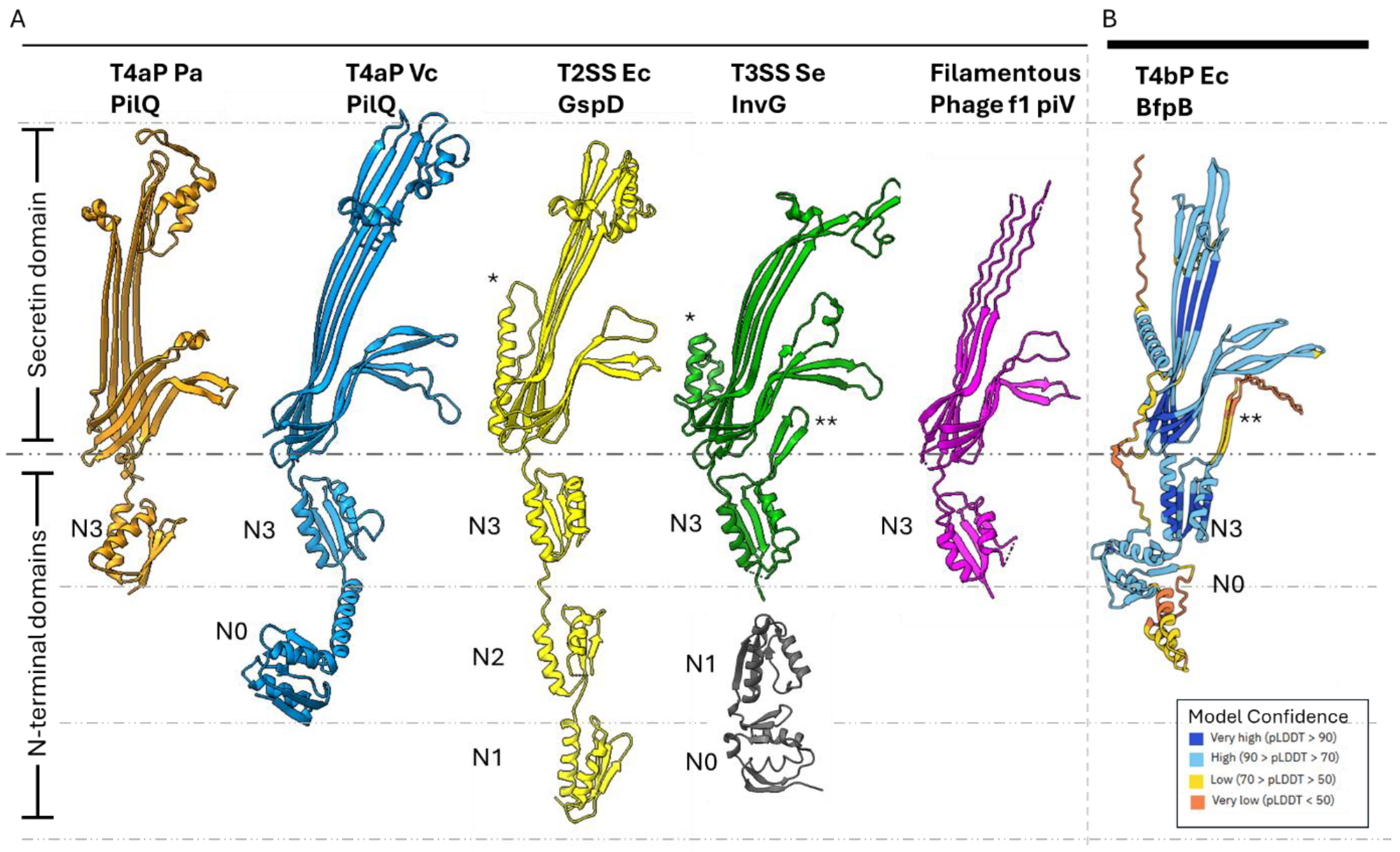

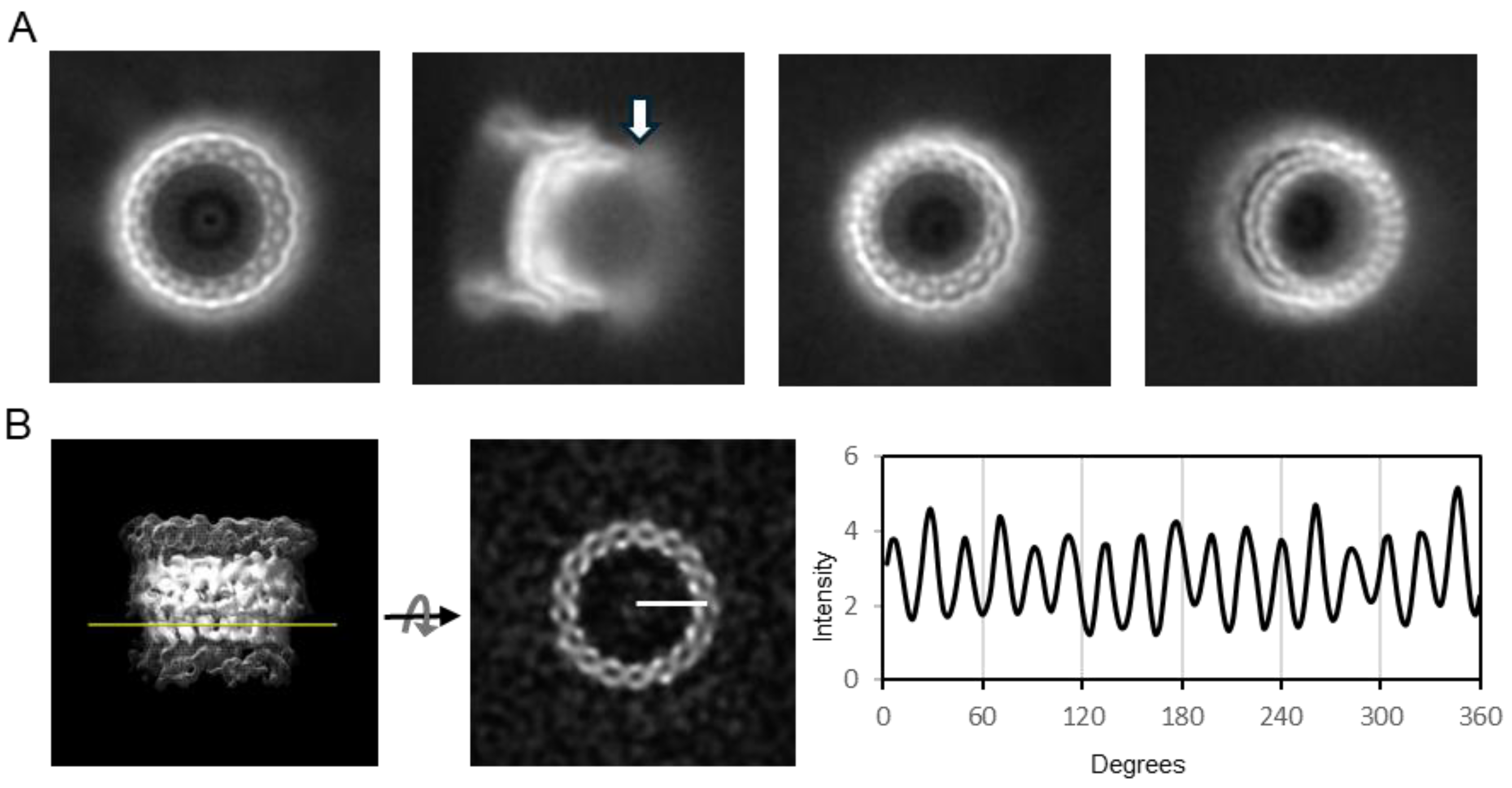
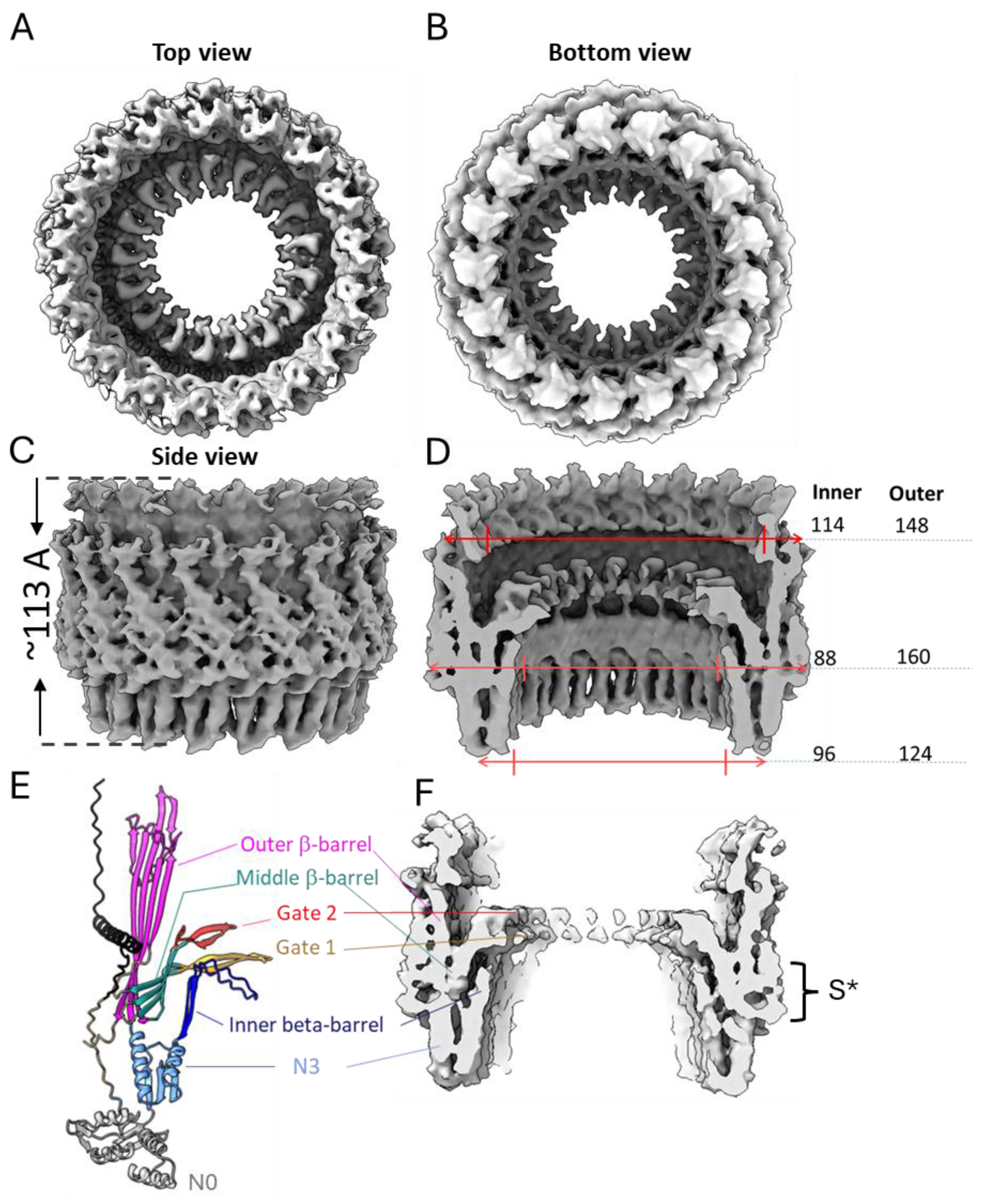
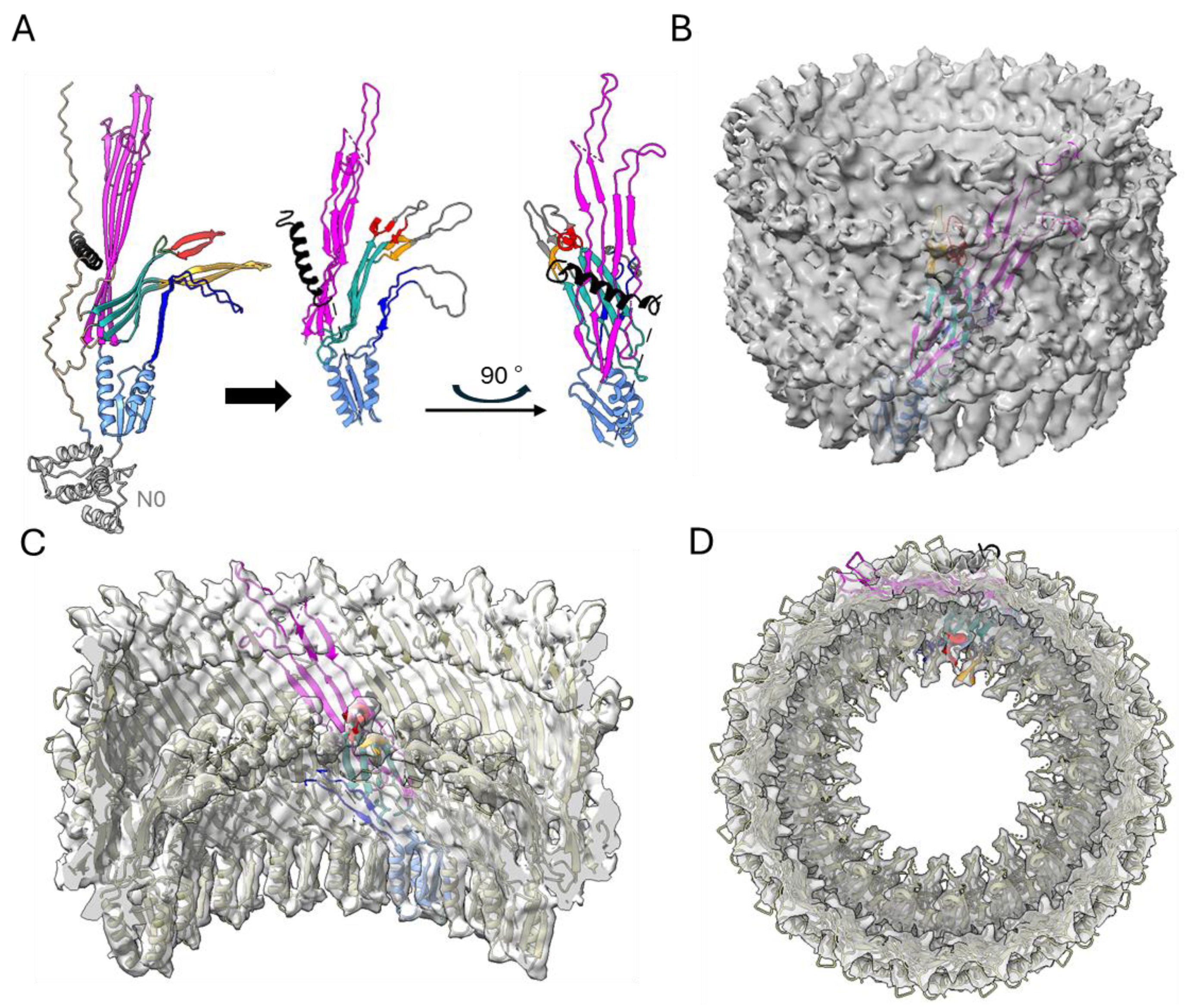

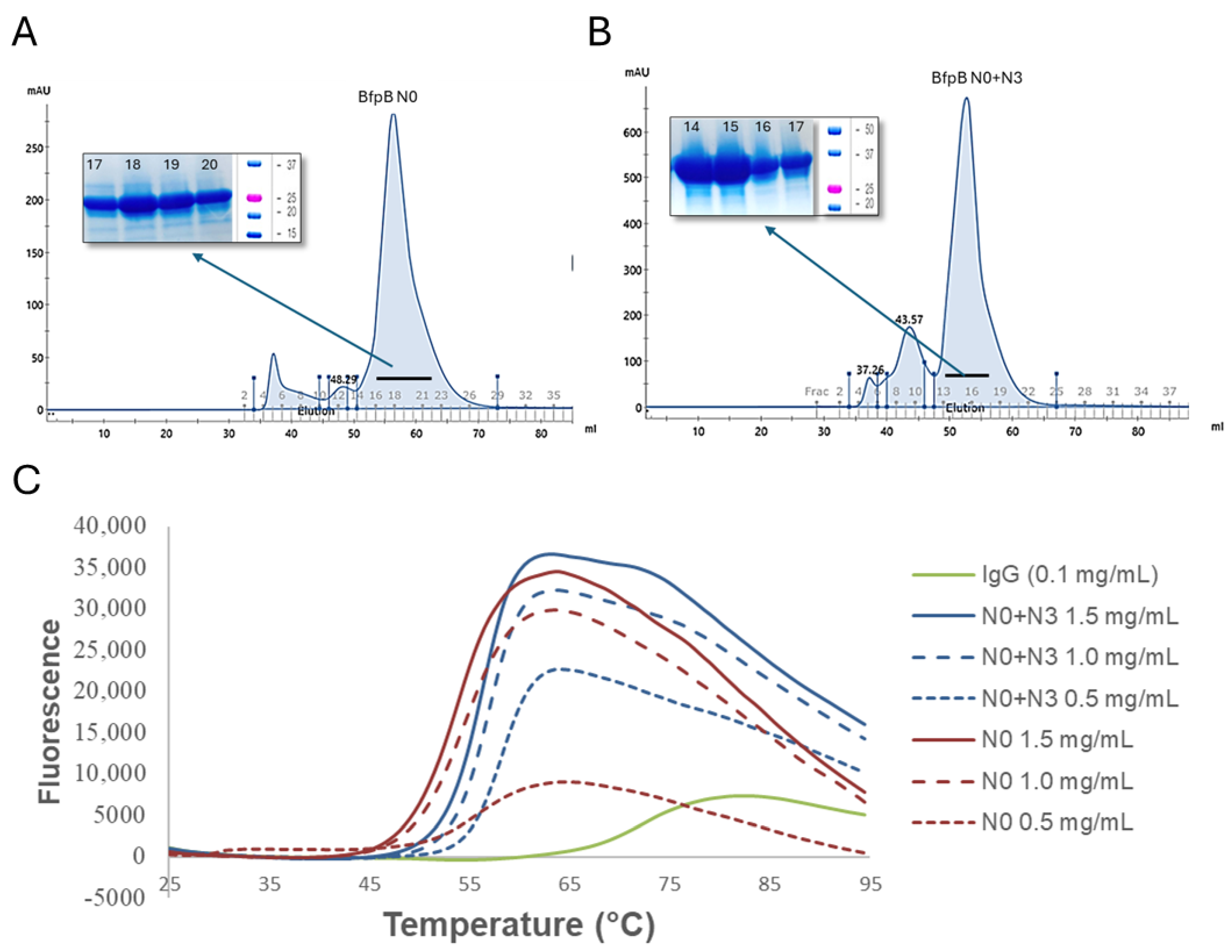
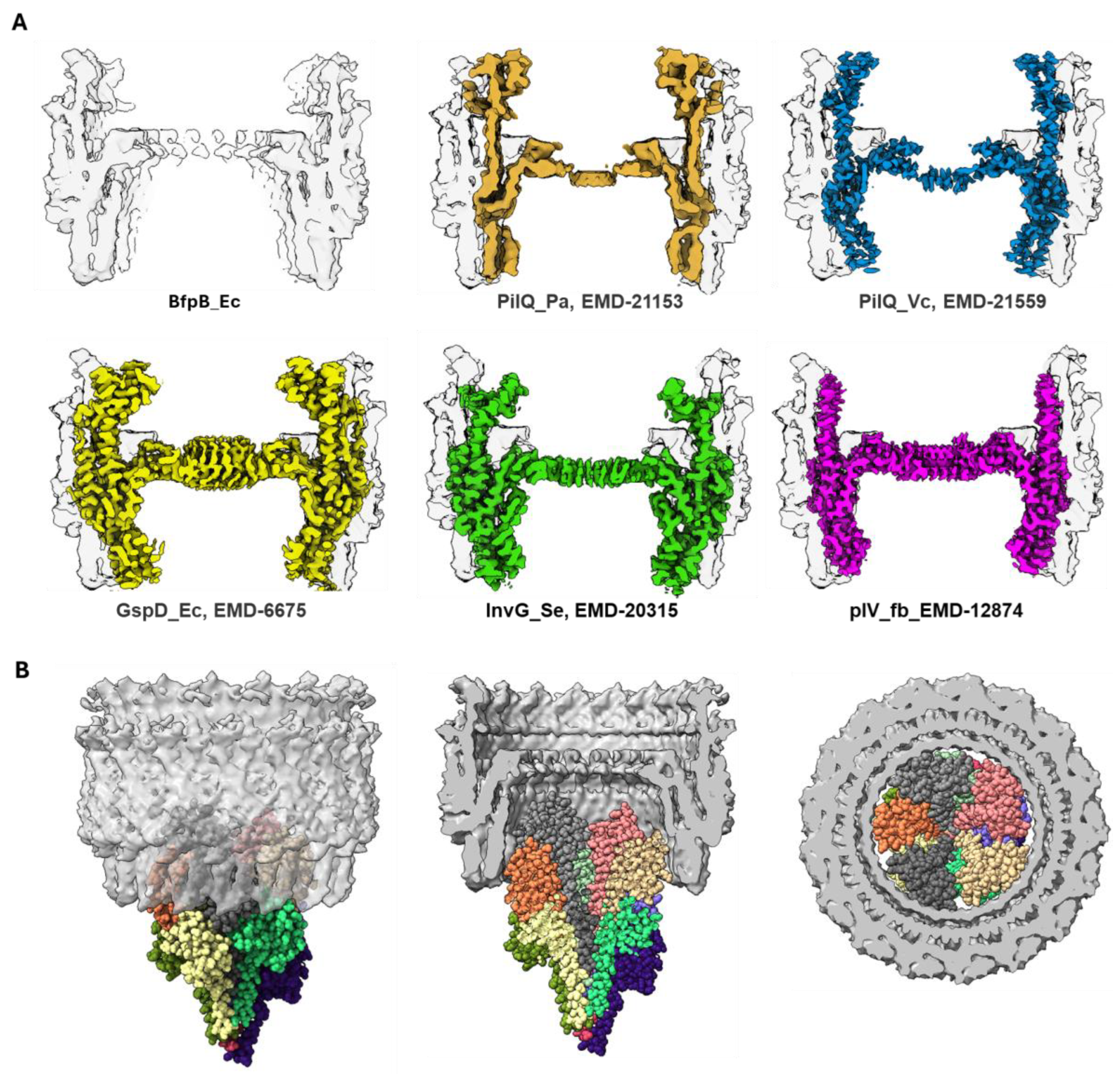
| Strain and Plasmid | Genotype or Description | Reference |
|---|---|---|
| E. coli XL1-Blue | recA1 endA1 gyrA96 thi-1 hsdR17 supE44 relA1 lac [F’ proAB lacIqZΔM15 Tn10 (TetR)] | Stratagene, La Jolla, CA, USA |
| E. coli BL21 (DE3) | F-, dmc, ompT, hsdS(rB-mB-) | Novagen, Burlington, MA, USA |
| E. coli DH5α | supE44ΔlacU169(φ80dlacZΔM15) hsdR17 recA1 endA1 gyrA96 thi-1 relA1 | Gibco-BRL, Carlsbad, CA, USA |
| pWS15 | bfpB-Strep gene cloned into pASK-IBA3 | [61] |
| pJIL003 | bfpB19-306 with C-terminal His tag cloned into pET28a NcoI and XhoI sites | This study |
| pJIL004 | bfpB19-202 with C-terminal His tag cloned into pET28a NcoI and XhoI sites | This study |
| Primer Name | Sequence (5′-3′) | |
| JIL-002 | GGCACCATGGGATCGGGTAATGGATTTTATAAAGATAATCTTGGCG | |
| JIL-003 | CCGTCTCGAGAGTTTCCTCGTTTGAAAAAGCAATCC | |
| JIL-005 | GGCCTCGAGTCTTTCAAGCTGTGCATTCAGTGTATTAATATATTCG |
| System Type | Secretin Name | No. of Subunits | Outer Diameter (Å) | Inner Diameter (Å) # | Substrate Diameter (Å) | Sources |
|---|---|---|---|---|---|---|
| T4bP | BfpB_Ec (EMD-70296) * | 17 * | ~160 * | ~88 * | 85 (1ZWT) | [60] |
| TcpC_Vc | Unknown | 80 (3HRV) | [74] | |||
| PilN_Se | Unknown | 100 (1Q5F) | [75] | |||
| T4aP | PilQ_Pa (EMD-21153) | 14 | 112 | ~79 | 60 | [49] |
| PilQ_Tt (EMD-3985) | 13 | 115 | ~70 | 45–70 | [33] | |
| PilQ_Vc (EMD21559) | 14 | 122 | ~77 | 60 | [39] | |
| T2SS | GspD_Ec (EMD-6675) | 15 | 120 | ~73 | 70 | [69] |
| GspD_Vc (EMD-6676) | 15 | 119 | ~73 | 65 (cholera toxin) | [69] | |
| T3SS | InvG_Se (EMD-20315) | 15 | 125 | ~72 | 70 (6ZNH) | [68] |
| MxiD_Sf (EMD-15701) | 15 | ~138 | ~78 at most | -- | [70] | |
| Filamentous Phage | pIV (EMD-12874) | 15 | 121 | ~77 | 60 (2C0W) | [30] |
Disclaimer/Publisher’s Note: The statements, opinions and data contained in all publications are solely those of the individual author(s) and contributor(s) and not of MDPI and/or the editor(s). MDPI and/or the editor(s) disclaim responsibility for any injury to people or property resulting from any ideas, methods, instructions or products referred to in the content. |
© 2025 by the authors. Licensee MDPI, Basel, Switzerland. This article is an open access article distributed under the terms and conditions of the Creative Commons Attribution (CC BY) license (https://creativecommons.org/licenses/by/4.0/).
Share and Cite
Little, J.I.; Singh, P.K.; Samsó, M.; Donnenberg, M.S. Cryo-Electron Microscopy of BfpB Reveals a Type IVb Secretin Multimer Adapted to Accommodate the Exceptionally Wide Bundle-Forming Pilus. Pathogens 2025, 14, 471. https://doi.org/10.3390/pathogens14050471
Little JI, Singh PK, Samsó M, Donnenberg MS. Cryo-Electron Microscopy of BfpB Reveals a Type IVb Secretin Multimer Adapted to Accommodate the Exceptionally Wide Bundle-Forming Pilus. Pathogens. 2025; 14(5):471. https://doi.org/10.3390/pathogens14050471
Chicago/Turabian StyleLittle, Janay I., Pradip Kumar Singh, Montserrat Samsó, and Michael S. Donnenberg. 2025. "Cryo-Electron Microscopy of BfpB Reveals a Type IVb Secretin Multimer Adapted to Accommodate the Exceptionally Wide Bundle-Forming Pilus" Pathogens 14, no. 5: 471. https://doi.org/10.3390/pathogens14050471
APA StyleLittle, J. I., Singh, P. K., Samsó, M., & Donnenberg, M. S. (2025). Cryo-Electron Microscopy of BfpB Reveals a Type IVb Secretin Multimer Adapted to Accommodate the Exceptionally Wide Bundle-Forming Pilus. Pathogens, 14(5), 471. https://doi.org/10.3390/pathogens14050471







